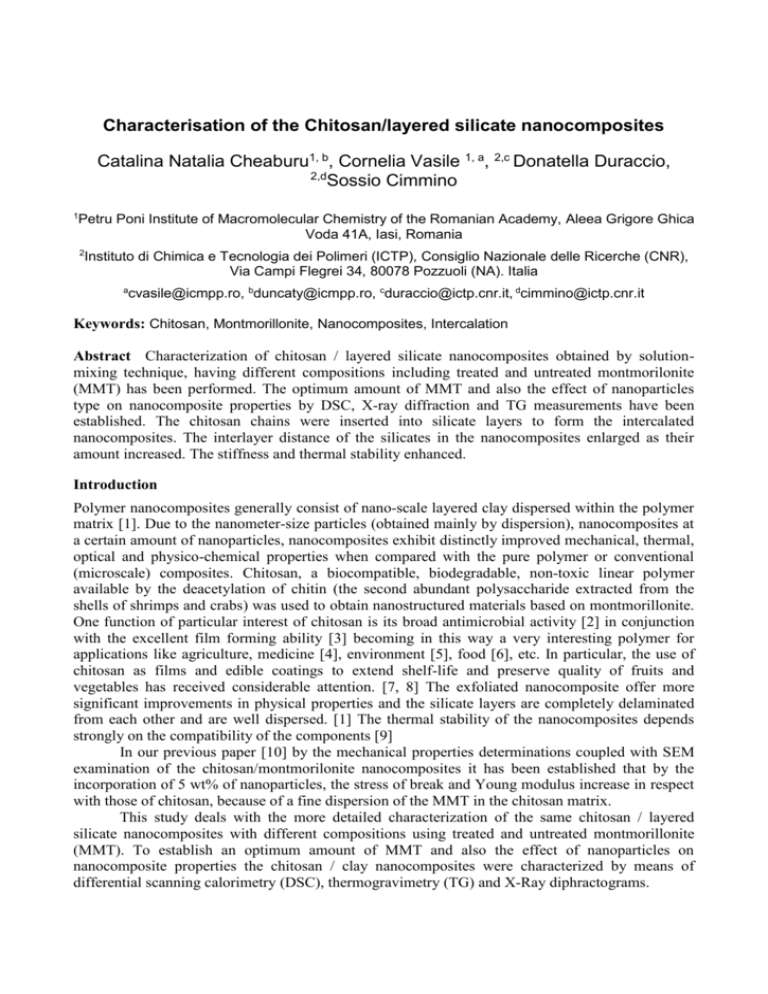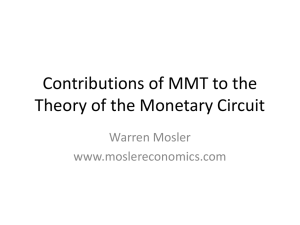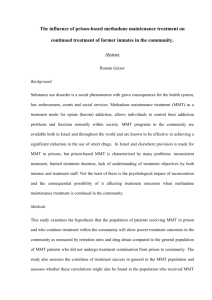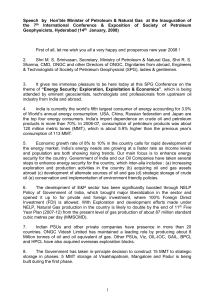Characterisation of the Chitosan/layered silicate nanocomposites
advertisement

Characterisation of the Chitosan/layered silicate nanocomposites Catalina Natalia Cheaburu1, b, Cornelia Vasile 1, a, 2,c Donatella Duraccio, 2,d Sossio Cimmino 1 Petru Poni Institute of Macromolecular Chemistry of the Romanian Academy, Aleea Grigore Ghica Voda 41A, Iasi, Romania 2 Instituto di Chimica e Tecnologia dei Polimeri (ICTP), Consiglio Nazionale delle Ricerche (CNR), Via Campi Flegrei 34, 80078 Pozzuoli (NA). Italia a cvasile@icmpp.ro, bduncaty@icmpp.ro, cduraccio@ictp.cnr.it, dcimmino@ictp.cnr.it Keywords: Chitosan, Montmorillonite, Nanocomposites, Intercalation Abstract Characterization of chitosan / layered silicate nanocomposites obtained by solutionmixing technique, having different compositions including treated and untreated montmorilonite (MMT) has been performed. The optimum amount of MMT and also the effect of nanoparticles type on nanocomposite properties by DSC, X-ray diffraction and TG measurements have been established. The chitosan chains were inserted into silicate layers to form the intercalated nanocomposites. The interlayer distance of the silicates in the nanocomposites enlarged as their amount increased. The stiffness and thermal stability enhanced. Introduction Polymer nanocomposites generally consist of nano-scale layered clay dispersed within the polymer matrix [1]. Due to the nanometer-size particles (obtained mainly by dispersion), nanocomposites at a certain amount of nanoparticles, nanocomposites exhibit distinctly improved mechanical, thermal, optical and physico-chemical properties when compared with the pure polymer or conventional (microscale) composites. Chitosan, a biocompatible, biodegradable, non-toxic linear polymer available by the deacetylation of chitin (the second abundant polysaccharide extracted from the shells of shrimps and crabs) was used to obtain nanostructured materials based on montmorillonite. One function of particular interest of chitosan is its broad antimicrobial activity [2] in conjunction with the excellent film forming ability [3] becoming in this way a very interesting polymer for applications like agriculture, medicine [4], environment [5], food [6], etc. In particular, the use of chitosan as films and edible coatings to extend shelf-life and preserve quality of fruits and vegetables has received considerable attention. [7, 8] The exfoliated nanocomposite offer more significant improvements in physical properties and the silicate layers are completely delaminated from each other and are well dispersed. [1] The thermal stability of the nanocomposites depends strongly on the compatibility of the components [9] In our previous paper [10] by the mechanical properties determinations coupled with SEM examination of the chitosan/montmorilonite nanocomposites it has been established that by the incorporation of 5 wt% of nanoparticles, the stress of break and Young modulus increase in respect with those of chitosan, because of a fine dispersion of the MMT in the chitosan matrix. This study deals with the more detailed characterization of the same chitosan / layered silicate nanocomposites with different compositions using treated and untreated montmorillonite (MMT). To establish an optimum amount of MMT and also the effect of nanoparticles on nanocomposite properties the chitosan / clay nanocomposites were characterized by means of differential scanning calorimetry (DSC), thermogravimetry (TG) and X-Ray diphractograms. Experimental Details on the materials can be found in the previous paper [10]. The characteristics of other materials used in this study are; Cloisite 15A is a natural montmorillonite modified with a quaternary ammonium salt 2M2HT -dimethyl, dehydrogenated tallow, quaternary ammonium, Southern Clay Product Inc from Rockwood Additives Ltd. Cloisite 93A is a natural montmorillonite modified with a quaternary ammonium salt M2HT-methyl, dehydrogenated tallow ammonium, Southern Clay Product Inc from Rockwood Additives Ltd. The thin film of the chitosan/ clay nanocomposites were obtained by casting on Petri dishes the viscous solutions of chitosan and clay dispersions and air dried by evaporation. Two series of samples have been investigated namely: (1) the nanocomposites containing variable content of clay from 1 to 15 wt% and (2) nanocomposites with a constant amount of 5 wt% of diferent types of nanoparticles. Investigation methods: DSC measurements were performed by using a Diamond Perkin Elmer instrument and the thermal program used was from 30°C to 130°C at 20°C/min; 130°C for two hours from 130 to -10°C at 50°C/min; kept at -10°C for 5 minutes from -10°C to 200°C at 10°C/min in order to remove the traces of solvent and to evidence better the glass transition. The WAXD measurements were carried out at room temperature with a Philips PW 3710 Wide Angle Xray Diffraction (WAXD) (Cu-Ni radiation, λ= 0.154 Å). The distances between clay layers were calculated with Bragg’s law: 2d sin θ = nλ; where λ is the wavelength of the X-ray d is the interspacing distance and θ is the angle of incident radiation. TG/DTG analyses were performed by a Diamond Perkin Elmer (TGA/DTA) apparatus with a heating rate of 10°C/min in nitrogen atmosphere from 25 to 500°C. Results and discussion DSC results are presented in Fig. 1 and Table 1. Two transition temperatures have been detected in the temperature range studied (room temperature – 200°C) (Table 1) in 110- 125°C and 168- 173°C region. The first one is not influenced by the nanocomposite content while the second one increases with both Na+MMT and C30B content up to 6 oC in respect with that of chitosan film. The data are in accordance with those obtained by DMTA, but the first temperature region is situate at high temperature in DSC curves because the heating rate used was higher (2°C/ min in DMTA and 20°C/ min in DSC). CSflakes CS film CS-C30B 5 wt% CS- C93A 5 wt% + CS- Na MMT 5 wt% CS- C15A 5 wt% (a) 100 120 140 160 Temperature (oC) 180 200 CS film First derivative First Derivative CS flakes + CS-Na MMT 1 wt% + CS-Na MMT 3 wt% + CS-Na MMT 5 wt% + CS-Na MMT 7 wt% + CS-Na MMT9 wt% (b) 100 + CS-Na MMT 15 wt% 120 140 160 180 200 Temperature (°C) Fig. 1: DSC thermograms for the nanocomposites based on chitosan with various amounts of clay; (a) and with a constant amount of clay (5 wt %) with different types (b) Table 1: The Tg values determined from the first derivative of DSC thermograms From the first derivative of DSC thermograms Sample First peak [°C] Second peak [°C] CS film CS-flakes CS-Na+MMT 1 wt% CS-Na+MMT 3 wt% CS-Na+MMT 5 wt% CS-Na+MMT 7 wt% CS-Na+MMT 9 wt% CS-Na+MMT 15 wt% CS-C30B 3 wt% CS-C30B 5 wt% CS-C30B 7 wt% CS-C93A 5 wt% CS-C15A 5 wt% 123 125 120 115 113 116 121 124 124 124 124 122 124 From DMTA T2 [oC] T1 [oC] 168 171 173 170 168 170 169 174 170 172 172 171 51; 105 156 100 75 170 167 91.8 84 175 168 X-Ray Patterns 4.96 o o 4.93 3.45 (a) o 4.85 2.8 + 4.83 o + CS- Na MMT 5 wt% o 4.93 + CS- Na MMT 3 wt% o 7.2 4.91 4.87 o C30B o CS-C30B 7% 4.8 o CS- C30B 5% o C93A 4.79 o CS-C93A 5 wt% 4.87 2.8 o C30B o CS-C30B 5 wt% 2 o C15A CS-Na+MMT 1wt% o CS CS 10 deg) 20 7.2 CS-C30B 3% + Na MMT 0 Intensity (u.a.) Intensity (u.a.) CS- Na MMT 7 wt% 4.83 Intensity (u.a.) CS- Na MMT15 wt% + (c) (b) o 4.83 o CS-C15A 5 wt% + Na MMT o + CS- Na MMT 5 wt% CS 5 10 2 (deg) 15 2 4 6 8 10 2 (deg) Fig. 2: X-ray patterns of nanocomposites based on chitosan; nanocomposites with various amounts of clay, Na+MMT (a) and C30B (b), (c) nanocomposites with different clay type Because of the hydrophilic and cationic structure of chitosan in acidic medium, this biopolymer has a good miscibility with montmorillonite (especially with Na+MMT) and can easily intercalate into the interlayers by means of cationic exchange [11, 12] Fig. 2a shows the XRD patterns of Na+MMT, neat CS and its CS/Na+MMT nanocomposites with different Na+MMT amount. The XRD pattern of the MMT shows a reflection peak at about 2θ = 7.2o, corresponding to a basal spacing of 1.23 nm. The XRD pattern of CS shows the characteristic crystalline peaks at around 2θ~10º, 20ºand 25º- Figure 2a, according to literature data [13-14]. After montmorillonite incorporation within CS, the basal plane of Na+MMT at 2θ = 7.2º disappears, substituted by a new peak at around 2θ~ 4- 5º- Fig. 2a. The shift of the basal reflection of Na+MMT to lower angle indicates the formation of an intercalated nanostructure, while the peak broadening and intensity decrease most likely indicate the disordered intercalated or exfoliated structure.[9, 11, 15] In the case of unmodified MMT the interspace distance (d001) was enlarged from 1.23 nm to 1.91 nm with the increasing of the clay amount indicating a good intercalation of chitosan into the layers of clay. Fig. 2b shows the influence of the amount of clay content, particularly C30B, modified montmorillonite, on the interspace distance. In the Table 2 are summarized the obtained values for the nanocomposites based of chitosan and unmodified and modified clay. It can be observe that in the case of C30B there is no significant enlargement of the d001 which means that chitosan did not enter into the interlayers of C30B. In the case of Cloisite 30B, organically modified Na+ MMT with a quaternary ammonium salt, the clay became organic and its hydrophobicity increased. It was very difficult to disperse Cloisite 30B in the chitosan aqueous solution and to occur an intermolecular reaction between clay and chitosan in spite of the presence of the hydroxyl group in the gallery of Cloisite 30 B. Table 2: The obtained values of 2θ angles and d-spacing of nanocomposites based chitosan with various amount of clay and different types of clay. 2θ [deg] Sample + Na MMT CS- Na+MMT 1 wt% CS- Na+MMT 3 wt% CS- Na+MMT 5 wt% CS- Na+MMT 7 wt% CS- Na+MMT 15 wt% C30B d001 [nm] Sample 7.20 4.93 4.83 4.83 4.93 4.96 4.79 1.23 1.79 1.82 1.82 1.79 1.91 1.84 2θ [deg] d001 [nm] 4.80 4.87 4.91 3.45 2.80 2.80 2.00 1.84 1.81 1.8 2.56 3.15 3.15 4.41 CS-C30B 3 wt% CS-C30B 5 wt% CS-C30B 7wt% C93A CS- C93A 5 wt% C15A CS-C15A 5 wt% It is seems that the strong polar interactions, especially hydrogen bonding, critically affected the formation of intercalation and exfoliated nanocomposites. [16] A shift of 2θ to smaller angles was also observed in the case of modified mineral clays C93A and C15A showing an enlargement of the interspace distance d001 from 2.56 to 3.15 nm for C 93A and from 3.15 to 4.41 nm for C 15A. The peak of nanocomposite CS- C93A in comparison with C93A, presented in Figure 2c, shows a rather broaden peak indicating a developement of an exfoliated structure. TG/DTG results are given in Fig. 3 and Table 3: 100 90 CS-Na MMT 3 wt% + CS-Na MMT 5 wt% + 60 CS-Na MMT 15 wt% + CS-Na MMT 9 wt% 50 40 30 (a) 100 CS film 200 300 400 70 CS-Na+MMT 5 wt% 60 CS-C30B 5 wt% 500 60 50 40 40 (b) 100 Temperature (°C) 70 50 30 30 CS film 200 300 400 CS-C30B 3 wt% 80 CS-C93A 5 wt% W (%) + CS-Na MMT 1 wt% 80 W (%) W (%) 70 CS-C15A 5 wt% + CS-Na MMT 7 wt% CS flakes 90 CS flakes 90 + 80 100 100 CS flakes CS-C30B 5 wt% CS-C30B 7 wt % (c) 100 500 CS film 200 300 500 Temperature (°C) Temperature (°C) CS flakes CS flakes 400 CS flakes CS film CS film + CS- C30B 5 wt% CS- C30B 7 wt% (e) 0 First Derivative First Derivative CS- C30B 3 wt% + CS-Na MMT 9 wt% + CS-Na MMT 7 wt% + CS-Na MMT 5 wt% + CS-Na MMT 3 wt% + CS-Na MMT 1 wt% (f) 100 200 300 400 500 Temperature (oC) 0 First Derivative CS-Na MMT 15 wt% CS film + CS- Na MMT 5 wt% CS- C30B 5 wt% CS- C93A 5 wt% CS- C15A 5 wt% (g) 100 200 300 400 500 Temperature (oC) 0 100 200 300 400 500 Temperature (oC) Fig. 3: Thermogravimetric (TG) curves (above) and their derivative (DTG) (below) for nanocomposites based on chitosan with various amounts of clay, Na+MMT (a), (d) and C30B (b), (e) and nanocomposites with different clay type (c), (f). Table 3: TG data for nanocomposites based on chitosan with various amounts of clay and different clay types. Sample Ti* [oC] T*m [oC] Tf* [oC] ΔW [%] CS film CS-flakes CS-Na+MMT 1 wt% CS-Na+MMT 3 wt% CS-Na+MMT 5 wt% CS-Na+MMT 7 wt% CS-Na+MMT 9 wt% CS-Na+MMT 15 wt% CS-C30B 3 wt% CS-C30B 5 wt% CS-C30B 7 wt% CS-C93A 5 wt% CS-C15A 5 wt% 206 197 183 209 205 210 210 214 174 171 168 170 188 276 302 261 265 281 271 277 275 276 277 277 273 260 393 438 409 402 387 388 382 386 391 406 407 407 403 36.77 48 41.42 38.75 36 35.52 32.54 36.45 38.95 37.76 36.76 39.23 37.59 Ti- onset temperature, Tm- temperature corresponding to the maximum rate of weight loss; Tf- final temperature; ΔW- weight loss * Ti increases with increasing Na+MMT content, in other cases decreases and ΔW decreases indicating an enhancement of the thermal stability by Na+MMT incorporation in chitosan. References [1] T. J. Pinnavaia, G. W. Beall, Eds. Polymer-Clay Nanocomposites; John Wiley & Sons: Chichester, West Sussex, U.K. (2000) [2] N. R. Sudarshan, D.G. Hoover, D. Knorr, Food Biotechnol. 6, p. 257 (1992) [3] F.S. Kittur, K.R. Kumar, R.N. Tharanathan, Z. Lebensm.-Forsch. A 206, p. 44 (1998) [4] J.A .Ko, H. J. Park, S. J. Hwang, J.B. Park, J.S. Lee, Int. J. Pharm. 249, p.165 (2002) [5] L. Pietrelli, L. Xingrong, Annal. Chim. 94, p.389 (2004) [6] E. Agullo, M.S. Rodrıguez, V. Ramos, L. Albertengo, Macromol. Biosci.3, p. 521 (2003) [7] D.B. Worrell, C.M.S. Carrington, D.J. Huber, Postharvest Biol. Technol. 25, p. 33 (2002) [8] F. Shahidi, J.K.V. Arachchi,Y.-J. Jeon, Trends Food Sci. Technol. 10, p. 37 (1999) [9] E. Gunister , D. Pestreli , C. H. Unlu, O. Atici , N. Gungor, Carbohydr. Polym. 67, p. 358 (2007) [10] C. N. Duncianu, C. Vasile, Proceedings of the Polymer Processing Society 24th Annual Meeting -PPS-24 - June 15-19, Salerno (Italy) (2008) [11] S.F. Wang , L. Shen, Y.J. Tong, L. Chen, I.Y. Phang, P.Q. Lim, T.X. Liu, Polym. Degrad. Stab. 90, p.123 (2005) [12] M. Darder, M. Colilla, E. Ruiz-Hitzky, Chem Mater 15, p. 3774 (2003) [13] R. J. Samuels, J Polym Sci Polym Phys 19, p. 1081 (1981) [14] K. Ogawa, T Yui, M. Miya Biosci Biothechnol Biochem 1992; 56, p.858 [15] K. H. Liu, T.Y. Liu, S.Y. Chen , D. M. Liu, Acta Biomaterialia, 4, p. 1038 (2008) [16] Y. Xu, Xi Ren, M. A. Hanna, J. Appl. Polym. Sci., 99, p.1684 (2006)






